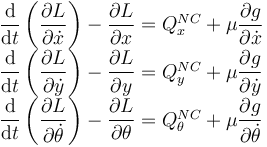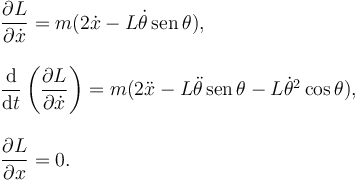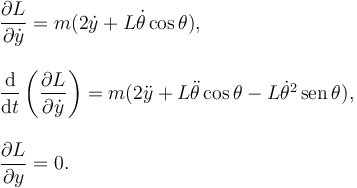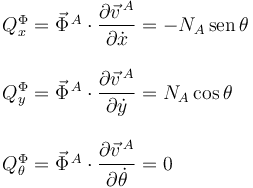Dos partículas unidas por una barra sin masa con una cuchilla, (MR)
De Laplace
Contenido |
1 Enunciado
Dos partículas puntuales de masa m están unidas por una barra de longitud L y masa despreciable. Las partículas deslizan sobre un plano fijo OX1Y1, pero una de las partículas tiene una cuchilla, de modo que su velocidad sólo puede tener componente paralela a la cuchilla. Una fuerza  constante actúa sobre la partícula que no tiene la cuchilla.
constante actúa sobre la partícula que no tiene la cuchilla.
- Encuentra la expresión del vínculo no holónomo del sistema.
- Escribe las ecuaciones de Lagrange utilizando la técnica de los multiplicadores de Lagrange.
- Identifica el significado físico del multiplicador de Lagrange.
2 Solución
2.1 Cinemática y vínculo
La reducción cinemática del sólido en el punto A es

La cuchilla hace que la velocidad del punto A tenga que ser paralela a la propia barra. Tenemos

La ligadura es

Esta es una ligadura cinemática no holónoma.
2.2 Ecuaciones de Lagrange
El sistema tiene tres grados de libertad, pero al ser una ligadura no holónoma, trabajaremos con tres coordenadas: {x,y,θ}. La ligadura no holónoma obliga a introducir un multiplicador de Lagrange.

Las tres ecuaciones de Lagrange son

La energía cinética es la suma de la energía cinética de las dos masas

Usando el Teorema de Chasles

Por tanto

La altura de las bolas no cambian, por lo que la energía potencial gravitatoria es constante y no hace falta considerarla. Así pues, la función Lagrangiana es

2.2.1 Ecuación para x
Tenemos

La contribución de la fuerza no conservativa es

Y la del multiplicador de Lagrange

La ecuación es

2.2.2 Ecuación para y
Tenemos

La contribución de la fuerza no conservativa es

Y la del multiplicador de Lagrange

La ecuación es

2.2.3 Ecuación para θ
Tenemos

La contribución de la fuerza no conservativa es

Y la del multiplicador de Lagrange

La ecuación es

La cuarta ecuación es el propio vínculo

Tenemos 4 incógnitas: {x,y,θ,μ} y 4 ecuaciones.
2.3 Significado físico del multiplicador
Si aplicásemos el Principio de Liberación, al liberar el vínculo sobre la partícula A tendríamos que incluir una fuerza vincular sobre ella perpendicular a la barra, pues ese es el movimiento prohibido de la partícula

La contribución de esta fuerza vincular a las diferentes componentes de fuerza generalizada serían

Comparando con las contribuciones del multiplicador de Lagrange vemos que
μ = − NA.







